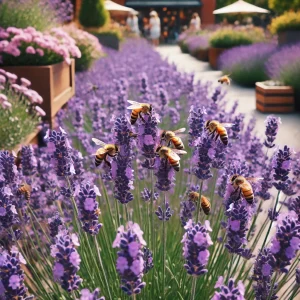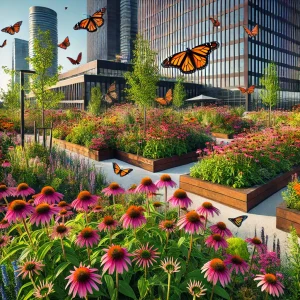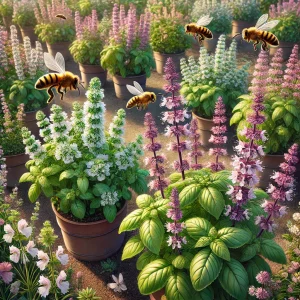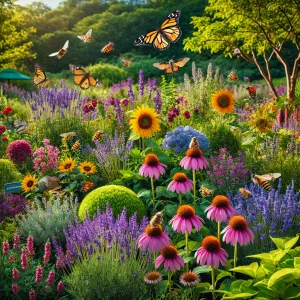In today’s world, commercial gardens—whether in office parks, shopping centers, or hotels—are more than just aesthetic spaces. They are vital to our urban environments, offering green relief amidst concrete and contributing to our well-being. One of the most effective ways to enhance these spaces is by fostering symbiotic relationships between plants and pollinators. This partnership creates vibrant and thriving gardens and supports biodiversity and sustainability.

The Power of Symbiotic Relationships
Symbiotic landscaping leverages the natural relationships between plants and pollinators to create lush, productive environments. These interactions benefit both parties: plants receive crucial pollination services, while pollinators gain access to food sources. Commercial gardens can achieve ecological balance and aesthetic appeal by understanding and implementing these relationships.

Lavender and Honeybees
Lavender is a classic example of a plant that forms a beneficial partnership with pollinators. Its fragrant purple flowers attract honey bees, essential for pollinating many plants. In commercial gardens, lavender can be strategically planted along pathways or in decorative beds. Not only does it provide a beautiful and calming visual element, but it also supports honeybee populations. The presence of honeybees enhances the garden’s overall health by increasing the pollination of other flowering plants.

Coneflowers and Butterflies
Coneflowers, or Echinacea, are another excellent choice for symbiotic landscaping. These vibrant, daisy-like flowers are known for attracting butterflies. In a commercial garden setting, coneflowers can add a splash of colour while serving as a food source for these pollinators. In turn, butterflies help pollinate coneflowers and other nearby plants, creating a dynamic and lively garden ecosystem. Planting coneflowers in clusters or mixed beds can create inviting spaces for visitors and beneficial insects.

Sunflowers and Bees
Sunflowers (Helianthus annuus) are striking with their towering blooms and bright yellow petals and are highly attractive to various bee species. They provide a generous supply of nectar and pollen, supporting the local bee population. Incorporating sunflowers into commercial gardens can create visually stunning displays while promoting pollinator health. They are particularly effective when planted in large groups, where their abundant resources can support a thriving community of bees.

Basil and Pollinators
Basil is more than just a culinary herb; it’s also a valuable plant for attracting pollinators. Its small, aromatic flowers attract bees and butterflies. In commercial garden settings, basil can be used in herb beds or decorative pots, adding functionality and beauty. The presence of basil can help create a garden that looks good and contributes to pollinator populations’ health.

Practical Tips for Implementing Symbiotic Landscaping
- Choose the Right Plants: Choose plants that are known to attract pollinators and suit your local climate. Consider a mix of flowering plants that bloom at different times to provide continuous food sources throughout the growing season.
- Create Pollinator Habitats: Incorporate features such as water sources, nesting sites, and shelter into your garden design. These elements help support a variety of pollinators and enhance their survival.
- Maintain the Relationships: Regularly monitor and care for your plants to ensure they remain healthy and continue providing pollinators resources. This includes managing pests, providing adequate water, and replacing plants.
- Educate and Engage: Use your commercial garden to educate visitors about the importance of pollinators. Signage, workshops, or guided tours can raise awareness and encourage others to implement similar practices in their spaces.
Symbiotic landscaping offers a powerful way to create thriving commercial gardens that benefit plants and pollinators. By integrating plants like lavender, coneflowers, sunflowers, and basil into garden designs, you can enhance the ecological value of these spaces while providing beauty and enjoyment for visitors. Embrace these natural partnerships, and watch your garden flourish with vibrant life and sustainability.